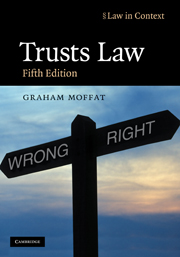Book contents
- Frontmatter
- Contents
- Preface to the fifth edition
- Acknowledgments
- Table of abbreviations
- Useful websites
- Table of statutes
- Table of statutory instruments
- Table of cases
- 1 Trusts introduced
- 2 The evolution of the private express trust
- 3 Taxation, wealth-holding and the private trust
- 4 Creating the trust – I
- 5 Creating the trust – II
- 6 Trusts and public policy
- 7 Flexibility in relation to beneficial entitlement
- 8 The taxation of private trusts
- 9 An introduction to trustees and trusteeship
- 10 Aspects of the management of trusts
- 11 Trusteeship, control and breach of trust
- 12 Implied trusts and the family home
- 13 Trusts in commerce I: occupational pension schemes
- 14 Trusts in commerce II: commerce and equitable remedies
- 15 Trusts in commerce III: commerce, credit and the trust
- 16 Trusts in commerce IV: fiduciary relationships, commerce and the trust
- 17 Trust, contract and unincorporated associations
- 18 An introduction to the law of charity
- 19 A legal definition of ‘charity’
- 20 The regulation of charities
- Index
14 - Trusts in commerce II: commerce and equitable remedies
- Frontmatter
- Contents
- Preface to the fifth edition
- Acknowledgments
- Table of abbreviations
- Useful websites
- Table of statutes
- Table of statutory instruments
- Table of cases
- 1 Trusts introduced
- 2 The evolution of the private express trust
- 3 Taxation, wealth-holding and the private trust
- 4 Creating the trust – I
- 5 Creating the trust – II
- 6 Trusts and public policy
- 7 Flexibility in relation to beneficial entitlement
- 8 The taxation of private trusts
- 9 An introduction to trustees and trusteeship
- 10 Aspects of the management of trusts
- 11 Trusteeship, control and breach of trust
- 12 Implied trusts and the family home
- 13 Trusts in commerce I: occupational pension schemes
- 14 Trusts in commerce II: commerce and equitable remedies
- 15 Trusts in commerce III: commerce, credit and the trust
- 16 Trusts in commerce IV: fiduciary relationships, commerce and the trust
- 17 Trust, contract and unincorporated associations
- 18 An introduction to the law of charity
- 19 A legal definition of ‘charity’
- 20 The regulation of charities
- Index
Summary
Introduction
The last decade of the twentieth century witnessed a fascinating resurgence of interest in, commentary on and litigation about equitable remedies. There are many reasons for this trend that has continued unabated but a prominent one is the presence of fraud. In litigation the aftermath of the collapses of BCCI and Asil Nadir's Polly Peck company, the Maxwell saga and mortgage fraud all made their contribution. One consequence ‘is that courts are increasingly concerned with attempts by the victims of fraud to trace their money and recover it, not from the fraudsters or their confederates, who have usually disappeared, but from those through whose hands it has passed’ (Millett QC (now Lord Millett) ‘Tracing the Proceeds of Fraud’ (1991) 107 LQR 71). Frequently the passage of money has involved sophisticated exercises in money laundering, often through bank accounts in several countries. Put simply money laundering is the process by which the proceeds of fraud or some other criminal activity are converted into assets which appear to have a legitimate origin, the purpose of the process being that the assets can then be retained permanently or even possibly recycled to finance further crimes. The process of tracing and the legal remedies by which the proceeds of fraud may be recovered have involved to some degree the processes and remedies provided by equity, and it is broadly within this commercial context that our study of equitable remedies is located.
- Type
- Chapter
- Information
- Trusts LawText and Materials, pp. 713 - 794Publisher: Cambridge University PressPrint publication year: 2009



